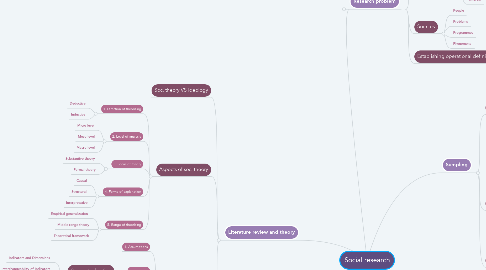
1. Inform others
2. Select a topic
3. Literature review and theory
3.1. Soc. theory VS Ideology
3.2. Aspects of soc. theory
3.2.1. 1. Direction of theorizing
3.2.1.1. Deductive
3.2.1.2. Inductive
3.2.2. 2. Level of analysis
3.2.2.1. Micro level
3.2.2.2. Meso level
3.2.2.3. Macro level
3.2.3. 3. Focus of theory
3.2.3.1. Substantive theory
3.2.3.2. Formal theory
3.2.4. 4. Forms of explanation
3.2.4.1. Causal
3.2.4.2. Structural
3.2.4.3. Interpretative
3.2.5. 5. Range of theorizing
3.2.5.1. Empirical generalization
3.2.5.2. Middle-range theory
3.2.5.3. Theoretical framework
3.3. Parts of soc. theory
3.3.1. 1. Assumptions
3.3.2. 2. Concepts
3.3.2.1. Conceptualization
3.3.2.1.1. Indicators and Dimensions
3.3.2.1.2. The Interchangeability of Indicators
3.3.2.1.3. Real, Nominal, and Operational Definitions
3.3.3. 3. Relationships
3.3.4. 4. Units of analysis
3.3.4.1. Units
3.3.4.1.1. Individuals
3.3.4.1.2. Groups
3.3.4.1.3. Organizations
3.3.4.1.4. Social Artifacts
3.3.4.1.5. Social Interactions
3.3.4.2. Faulty reasoning
3.3.4.2.1. Ecological fallacy
3.3.4.2.2. Reductionism
4. Research problem
4.1. Considerations
4.1.1. Magnitude
4.1.2. Measurement of concepts
4.1.3. Level of expertise
4.1.4. Relevance
4.1.5. Ethical issues
4.1.6. Interest
4.2. Sources
4.2.1. People
4.2.2. Problems
4.2.3. Programmes
4.2.4. Phenomena
4.3. Establishing operational definitions
5. Validity and reliability
5.1. Types of validity
5.1.1. Face validity
5.1.2. Content validity
5.1.3. Concurrent validity
5.1.4. Convergent validity
5.1.5. Discriminant validity
5.2. Types of reliability
5.2.1. Test-Retest reliability
5.2.2. Split-Half method
5.2.3. Using established measurement
5.2.4. Inter-Rater reliability
5.2.5. Parallel-Forms reliability
5.2.6. Internal Consistency reliability
6. Ethical principles
6.1. Harm to participants
6.2. Lack of informed consent
6.3. Invasion of privacy
6.4. Deception
7. Collect data
8. Analyze the data
9. Interpret the data
10. Sampling
10.1. Quantitative
10.1.1. Non-probability sampling
10.1.1.1. Convenience sampling
10.1.1.2. Snowball sampling
10.1.1.3. Quota sampling
10.1.2. Probability sampling
10.1.2.1. Simple random sample
10.1.2.2. Systematic sample
10.1.2.3. Stratified random sampling
10.1.2.4. Multi-stage cluster sampling
10.2. Qualitative
10.2.1. Purposive sampling
10.2.1.1. Extreme or deviant case sampling
10.2.1.2. Typical case sampling
10.2.1.3. Critical case sampling
10.2.1.4. Maximum variation sampling
10.2.1.5. Criterion sampling
10.2.1.6. Theoretical sampling
10.2.1.7. Snowball sampling
10.2.1.8. Opportunistic sampling
10.2.1.9. Stratified purposive sampling
10.3. Sample size
11. Research design
11.1. Techniques
11.1.1. Experimental
11.1.2. Cross-sectional
11.1.3. Case study
11.1.4. Comparative
11.1.5. Longitudinal
11.2. Method
11.2.1. Qualitative
11.2.2. Mixed methods
11.2.3. Quantitative

